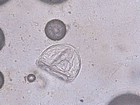Difference between revisions of "Anoplocephala"
| Line 15: | Line 15: | ||
=== Life-Cycle === | === Life-Cycle === | ||
| − | Each worm has male and female segments, which reproduce via hemaphroditism. The male segment fertilises the female segment. The reproductive organs then deteriorate, leaving only a uterus full of eggs. | + | Each worm has male and female segments, which reproduce via hemaphroditism. The male segment fertilises the female segment. The reproductive organs then deteriorate, leaving only a uterus full of eggs. This then detachesfrom the rest of the worm and migrates to the large intestine, where it ruptures releasing the eggs. |
| + | |||
| + | The eggs released are infective to oribatid mites, which act as the intermediate host. | ||
The intermediate hosts of ''A. perfoliata'' are free-living pasture mites. These are ubiquitous, but most numerous on permanent pasture in the summer months. The metacestode form is the cysticercoid. Horses become infected by ingesting the mites while grazing. | The intermediate hosts of ''A. perfoliata'' are free-living pasture mites. These are ubiquitous, but most numerous on permanent pasture in the summer months. The metacestode form is the cysticercoid. Horses become infected by ingesting the mites while grazing. | ||
Revision as of 15:12, 13 July 2010
| This article is still under construction. |
Introduction
Several species of Anoplocephala occur in equidae, but A. perfoliata is the only common species in the UK. It is an equine cestode, more commonly known as a tapeworm. It is currently commonly seen in horses within the UK, usually affecting younger horses.
Recognition
- Superficially, A. perfoliata looks more like a trematode than a tapeworm, but closer inspection reveals that the body compromises many segments that are wide, but very short.
- It typically grows to approximately 5cm, but can be longer.
- The gravid segment contains characteristic eggs with a ‘rounded triangular’ shape.
- The oncosphere is contained in the ‘pyriform apparatus’ (a chitinous ring with two projections).
- The eggs do not float well in the flotation fluids used in routine faecal examination and may be overlooked. Special techniques are required for this purpose, but none are reliable. An ELISA has therefore been developed to demonstrate specific antibodies in blood.
Life-Cycle
Each worm has male and female segments, which reproduce via hemaphroditism. The male segment fertilises the female segment. The reproductive organs then deteriorate, leaving only a uterus full of eggs. This then detachesfrom the rest of the worm and migrates to the large intestine, where it ruptures releasing the eggs.
The eggs released are infective to oribatid mites, which act as the intermediate host. The intermediate hosts of A. perfoliata are free-living pasture mites. These are ubiquitous, but most numerous on permanent pasture in the summer months. The metacestode form is the cysticercoid. Horses become infected by ingesting the mites while grazing.
A. perfoliata is found mainly in the caecum, clustered around the ileo-caecal junction, where it causes superficial ulceration and mild inflammation. Generally, it is of little clinical significance, but epidemiological evidence suggests that heavy infections (greater than 20 tapeworms) are a significant risk factor in some forms of colic.
